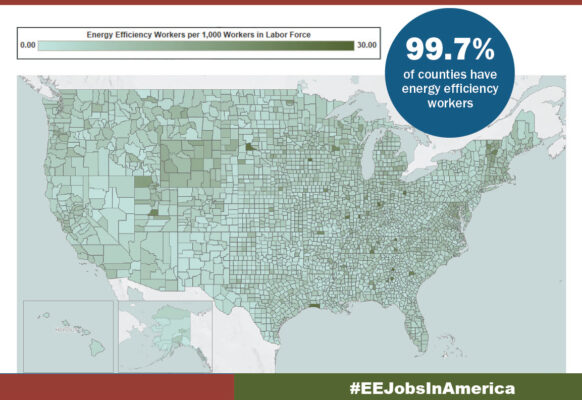by Pat Stanton
Energy efficiency (EE) initiatives are needing increased attention with new federal funds. This translates into more jobs on the way. Energy Efficiency Jobs in America shows there are nearly 2.2 million efficiency workers, and the number will rise as infrastructure investments kick in this year. Making these workforce statistics available now is important, so that we have a baseline for comparison.
As you may have heard, EE jobs represent the largest portion of the overall U.S. clean energy workforce. In fact, EE jobs are the largest portion of the entire U.S. energy sector except for vehicle-related energy jobs.
EE jobs are in nearly every county. Some of your neighbors are likely to be EE workers if you live in a rural, suburban, or metropolitan area. These inherently local jobs cannot be outsourced. I encourage you to look up your county in our state fact sheets, and see how many energy efficiency workers live near you. I will bet you will be surprised.

Businesses, Workforce Development and Training
Despite the pandemic’s difficult setback for EE businesses nationwide, these businesses are rebounding well. And the wheels are now in motion to address workforce supply challenges. New workforce development and training initiatives are popping up across the country.
Federal Investments
I have waited many years for EE to be better prioritized with federal policy solutions. It’s a win-win that deserves to be prioritized, with long-term benefits.
Policy support will help states to effectively implement the EE provisions in Inflation Reduction Act (IRA) and Infrastructure Investment and Jobs Act (IIJA). Along with a focus on implementation, continued funding for government-led EE activities is also crucial to realizing the benefits of EE and maximizing its potential. Investing in this industry benefits all local economies and communities.
Federal commitments spark private-sector investment. And in 2022, the whole world saw further confirmation of efficiency’s vital role, when armed conflict impacted fuel availability.
Resilience Matters
Costs from weather disasters are increasing dramatically, as discussed in the jobs report. Why does this matter for jobs? Because making critical improvements to U.S. building stock will be essential for combating the worst impacts, and for bolstering the resilience of infrastructure.
Hundreds of thousands of workers will be needed to retrofit buildings across every state and county. They will design, install, repair, and manufacture essential components such as insulation, ENERGY STAR appliances, HVAC systems, building energy controls, and more.
In This Report
I hope you will dig into the report’s important statistics, and help spread the word about both the power and the necessity of a strong EE workforce. You’ll find details for all 50 states and the District of Columbia. For each:
- Job numbers by state, county and Metropolitan Area
- Recovery trend, post-pandemic
- EE businesses: Total number, firm sizes
- Energy sector size comparisons
- Demographics
- Percentages of military veterans, construction workers and union members
- Potential: Low-income (weatherization program) and market-rate homes; electricity use reduction
Contact policy@e4thefuture.org with questions, or to discuss any E4TheFuture initiatives.
–Pat Stanton is Executive Director of E4TheFuture
*site updated yearly with new statistics
